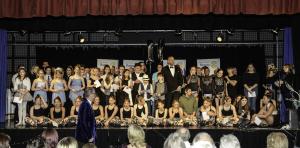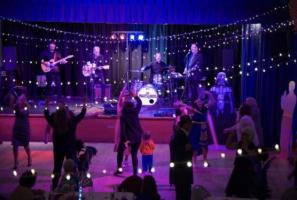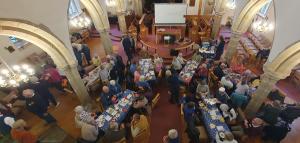Outside Visit - The Lace Market with Felicity Whittle
Thu, Jun 23rd 2022 at 7:00 pm - 9:00 pm
Club members please log in for more information.
23rd June 2022 Lace Market Walk - Blue Badge guide will be Felicity Whittle from Gold Star Guides
Our walking tour of the Lace Market with Felicity started at the top of Pelham Street, where Felicity explained a brief history of how "Snottngham " or Nottingham as is now known got its name from an Anglo-Saxon term,: home of the wise man's people, and how The Lace Market being the oldest area of Nottingham became the centre of the worlds lace industry during the British Empire. It started in 1808 when a man called John Heathcote developed a hand operated machine that marked the beginning of a lace industry. Later the Industrial Revolution changed things.
Felicity quoted a famous poem from Lord Byron and also mentioned the Luddites (named after Ned Ludd a mythical person believed to live in Sherwood Forest, and who led the movement). Lord Byron spoke out in defence of them in the House of Lords in early 1812 over the new work practices and new technology that they thought would threaten their jobs. They were known as Luddite "Frame breakers" and they rocked the wool and cotton industries. The peak of industry here was in the 1890's but by 1970s many of the factories became derelict and the area fell into rapid decline. By 1978 a huge clean up and grants offered meant that the buildings could be refurbished and renovated and new uses were found such as luxury apartments and offices.
We then moved on to The Lace Market square with its impressive historic buildings and 19th century architecture. Here sculptures represent the lace industry. It was never a market in the sense of having stalls but there were salesrooms and warehouses for displaying and selling the lace. All the buildings within this quarter of a mile are typical Victorian, red brick with large windows giving a sense of going back in time. The Adams Building here, now home to New College Nottingham was designed by Thomas Chambers and was built for Thomas Adams who was a notable Quaker who did much to improve the awful working conditions in his factories.
Felicity talked about how pre dating the arrival of the Normans, the Lace Market was the Saxon area of Nottingham, hence the place names: for example 'Gate' came from the Danish word Gata meaning street. Pilcher Gate, Fisher Gate, Fletcher Gate and many more.
On to The Contemporary Art Gallery next, a tourist attraction on High Pavement (one of the earliest streets in the city) which when looking closely has a lace patterned precast facade, again depicting the Lace trade.
It was built on the sloping site of Victorian railway cutting by well-known London based architects Caruso St John.
Moving on quickly now as we were starting to feel famished, we hit on the National Justice Museum. (The County Hall and the Edwardian Police Station). This is the largest museum in the UK dedicated to crime and punishment and has quite a few famous highlights including investigations into The Great Train Robbery. Felicity pointed out the misspelling of the word GAOL on the door of the building. A mistake made by the stonemason!! He would have been punished for this. The architect of this wonderful building was James Gamden and it was built in the 10th year of the reign of His Majesty George 3rd. There was a plaque to commemorate the life of Britain's first Black Magistrate
(Eric Irons). Born in Jamaica and then settled in Nottingham. He campaigned for social justice and equality and was made an OBE.
Along High Pavement we walked passed many interesting buildings with fascinating plaques. One with Queen Victoria.
We then came across the ancient St Marys church believed to be over 500 years old. Whilst pondering and looking at the names of the soldiers killed in the Great wars, we became intrigued by a Post Box. Felicity mentioned that on the front of every post box there is the name of the reigning Monarch so we will all be looking out for these in the future.
By this time all present felt a little fatigued so we briskly made our way back through the lace market and our last sighting was of a wall of legends. Pictures of famous people and objects that had come from Nottingham. Sue Pollard, Brian Clough, Wolfy (Robert Lindsay) and many more.
We thanked Felicity in the normal manner for a most informative tour and were upset to hear that she was retiring with no-one to replace her. What a shame as her knowledge was amazing. JH/MF
'What We Do' Main Pages:

We have now successfully run this event for 10 years. Full reports of each year are available under this main page
more
It's here that you can read what we've been up to in the last few months. For more information on our work in the local community, with our young people and internationally please access "what we do" section of this web site.
more
This is a monthly meeting open to visitors from Bingham, Radcliffe, Cotgrave and all villages in surrounding area.
moreThis committee are involved in planning now we can raise funds for our chosen charities
moreIf you like what we do as an organisation and are interested in volunteering with us, keeping up to date with our plans and future events then why not consider signing up as a friend of our Rotary Club
moreOur International Committee is involved with Polio Plus - a Rotary initiative to eradicate Polio, World-wide; Sand dams; Aqua Boxes; Shelter Boxes; Collecting used spectacles, and many other projects
moreHere you can read about the many meetings we've had during our formation as a Rotary Club. The early years are a little short on detail...
more






